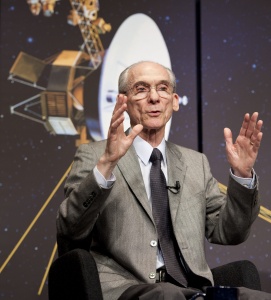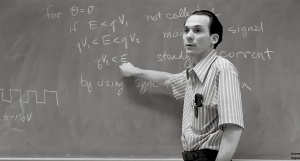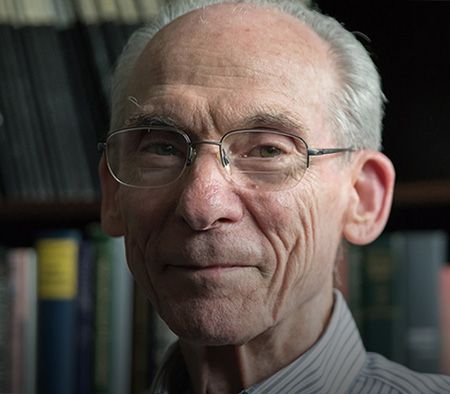Pasadena, California – Edward (Ed) C. Stone, the David Morrisroe Professor of Physics at Caltech, and the project scientist for NASA’s Voyager mission for the past 47 years, has been awarded the prestigious Shaw Prize in Astronomy “for his leadership in the Voyager project, which has, over the past four decades, transformed our understanding of the four giant planets and the outer solar system, and has now begun to explore interstellar space,” according to the award citation. The prize comes with a monetary award of $1.2 million.
“This is a tremendous honor,” says Stone, “and a tribute to the teams who designed, developed, launched, and operated Voyager on an inspiring journey of more than four decades.”
Since 1972, Stone has served as the project scientist for the Voyager mission, twin spacecraft designed to tour the solar system and its farthest reaches. The Voyager mission is managed by the Jet Propulsion Laboratory (JPL), which is managed for NASA by Caltech.

Voyager 2 launched in August 1977, and Voyager 1 soon followed, launching in September 1977. Some of the mission’s many highlights include the first high-resolution images of the four giant planets of our solar system (Jupiter, Saturn, Uranus, and Neptune); the discovery of volcanoes on Jupiter’s moon Io; the first images of rings of Jupiter, Uranus, and Neptune; and the discovery of gaps and other complex structures in Saturn’s rings.
In 2012, Voyager 1 became the first human-made object to cross into interstellar space, beyond the protective bubble, or heliosphere, that surrounds our solar system. Voyager 2 achieved this milestone more recently, in 2018. Both missions carry Golden Records of Earth sounds, music, images, and messages.
“This is great and well-deserved recognition of Ed’s leadership over the decades, and timely, since now both Voyager spacecraft have reached interstellar space,” says Fiona Harrison, Caltech’s Benjamin M. Rosen Professor of Physics and the Kent and Joyce Kresa Leadership Chair of the Division of Physics, Mathematics and Astronomy.
Stone was born in Knoxville, Iowa, on January 23, 1936. He graduated from Iowa’s Burlington Junior College in 1956 and earned his PhD in physics from the University of Chicago in 1964. Since the Voyager spacecraft launched in 1977, Stone has led and coordinated 11 instrument teams on the project. He also served as the director of JPL from 1991 to 2001, overseeing many space-based missions, including Cassini, and a program of Mars exploration that included Mars Pathfinder and its Sojourner rover.

“Ed has been a tireless advocate for science, space exploration, and international cooperation,” says George Djorgovski, executive officer and professor of astronomy at Caltech. “There are very few people like him who combine such scientific accomplishments and leadership with modesty and dedication.”
Stone also played a key role in the development of W. M. Keck Observatory on Maunakea, Hawaii. During the late 1980s through the 1990s, Stone served as vice chair and chair of the Board of Directors for the California Association for Research in Astronomy (CARA), which was responsible for carrying out plans for the observatory’s twin ten-meter telescopes, from concept to completion – a project that skeptics deemed impossible at the time.
“Ed, at the dedication of the observatory, said ‘we believed it could, now we know it does.’ It’s a philosophy that has defined his work and sets him apart as a leader,” said Hilton Lewis, director of Keck Observatory. “He was instrumental in Keck’s early years and played a key part of the governance that ensured our success. I’m thrilled to see Ed honored with one of the world’s most distinguished awards in astronomy. This recognition is fantastic and well-deserved.”
Stone is also on the board of the W. M. Keck Foundation. He is currently playing a similar role in the development of the planned Thirty Meter Telescope, an international partnership that includes the U.S., Canada, China, Japan, and India.
During Keck Observatory’s 20th anniversary celebration in 2013, Founding Chairman Ed Stone does a walkthrough starting with the early concept, through construction, to the first science from Keck Observatory.
He has served as a principal investigator on nine missions and a co-investigator on five additional missions. He has more than 1,000 publications in professional journals and conference proceedings, and has mentored a large number of students, postdocs, and research scientists. Stone is the recipient of numerous awards, including the President’s National Medal of Science (1991), the Magellanic Premium (1992), the Carl Sagan Memorial Award (1999), the Philip J. Klass Award for Lifetime Achievement (2007), the NASA Distinguished Public Service Medal (2013), and the Howard Hughes Memorial Award (2014). He is a member of the National Academy of Sciences.
The Shaw Prize is awarded annually in three categories: Astronomy, Life Science and Medicine, and Mathematical Sciences. It is an international award managed and administered by The Shaw Prize Foundation based in Hong Kong. Mr. Shaw has also founded The Sir Run Run Shaw Charitable Trust and The Shaw Foundation Hong Kong, both dedicated to the promotion of education, scientific and technological research, medical and welfare services, and culture and the arts.
The 2019 Shaw laureates will receive their awards in Hong Kong at the ceremonial prize-giving on Wednesday, September 25, 2019.
ABOUT W. M. KECK OBSERVATORY
The W. M. Keck Observatory telescopes are the most scientifically productive on Earth. The two, 10-meter optical/infrared telescopes atop Maunakea on the Island of Hawaii feature a suite of advanced instruments including imagers, multi-object spectrographs, high-resolution spectrographs, integral-field spectrometers, and world-leading laser guide star adaptive optics systems. The data presented herein were obtained at the W. M. Keck Observatory, which is operated as a scientific partnership among the California Institute of Technology, the University of California, and the National Aeronautics and Space Administration. The Observatory was made possible by the generous financial support of the W. M. Keck Foundation. The authors recognize and acknowledge the very significant cultural role that the summit of Maunakea has always had within the Native Hawaiian community. We are most fortunate to have the opportunity to conduct observations from this mountain.


